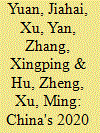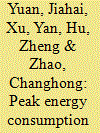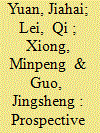|
|
|
Sort Order |
|
|
|
Items / Page
|
|
|
|
|
|
|
| Srl | Item |
| 1 |
ID:
127299


|
|
|
|
|
| Publication |
2014.
|
| Summary/Abstract |
China has proposed its 2020 clean energy target together with the climate change target of reducing CO2 intensity of the economy by 40-45% below the 2005 level. This article investigates the feasibility of these targets by testing their consistency under possible economic development scenarios. We analyse these targets from two perspectives: consistency with the overall economic growth and consistency with the international society's expectation on China's greenhouse gas (GHG) abatement responsibilities. The main findings are: under the recently announced 2020 target of gross domestic product (GDP) that is double the 2010 level, the adoption of a 15% clean energy target could result in excessive primary energy demand; and then with 40-45% GDP CO2 intensity reduction, CO2 emissions in 2020 could substantially exceed the International Energy Agency (IEA) 450 ppm scenario for China. Thus we propose a 17% clean energy target that can reconcile the domestic plan with international expectation. Our article also outlines the pathways to realise clean energy development into 2020 and proposes policy recommendations.
|
|
|
|
|
|
|
|
|
|
|
|
|
|
|
|
| 2 |
ID:
150058


|
|
|
|
|
| Summary/Abstract |
Electricity consumption growth in China has experienced radical adjustment from high speed to medium speed with the advent of new economy normal. However, the investment enthusiasm on coal power remains unabated and leads to continuous operation efficiency deterioration in recent years. In this paper, we quantify the rational capacity and potential investment of coal power in China during the 13th FYP period (2016–2020). By employing power planning model and fully considering the power sector's contribution in the 15% non-fossil primary energy supply target by 2020, we estimate that the reasonable capacity addition space of coal power ranges between 50 GW and 100 GW, depending on the expected range of demand growth. We find that if all the coal power projects submitted for Environmental Impact Assessment (EIA) approval were put into operation in 2020, capacity excess would reach 200 GW. Such huge overcapacity will bring forth disastrous consequences, including enormous investment waste, poor economic performance of generators and more importantly, delay of low-carbon energy transition. Finally, policy recommendations are proposed to address this issue.
|
|
|
|
|
|
|
|
|
|
|
|
|
|
|
|
| 3 |
ID:
116757


|
|
|
|
|
| Publication |
2012.
|
| Summary/Abstract |
This paper studies the transition to low carbon power systems in China. The methodology is built on the newly developed multi-level perspective (MLP) transitions, as well as literature on innovation systems. Three lines of thought on the transition process are integrated to probe the possible transition pathways in China's power sector. Five transition pathways, namely reproduction, transformation, substitution, reconfiguration, de-alignment/re-alignment and reconfiguration, with their possible technology options are presented. The requirements for a smart grid in the socio-technical transition process are addressed within the MLP framework. The paper goes further to propose an interactive framework for low carbon transition management in China. Representative technology options are appraised by employing innovation theory to demonstrate the logic of policy design within the framework. The work presented in this paper will be useful in informing policy-makers and other stakeholders in China and it may prove to be a valuable reference for other countries in energy transition management.
|
|
|
|
|
|
|
|
|
|
|
|
|
|
|
|
| 4 |
ID:
133251


|
|
|
|
|
| Publication |
2014.
|
| Summary/Abstract |
China is in the processes of rapid industrialization and urbanization. Based on the Kaya identity, this paper proposes an analytical framework for various energy scenarios that explicitly simulates China×s economic development, with a prospective consideration on the impacts of urbanization and income distribution. With the framework, China×s 2050 energy consumption and associated CO2 reduction scenarios are constructed. Main findings are: (1) energy consumption will peak at 5200-5400 million tons coal equivalent (Mtce) in 2035-2040; (2) CO2 emissions will peak at 9200-9400 million tons (Mt) in 2030-2035, whilst it can be potentially reduced by 200-300 Mt; (3) China×s per capita energy consumption and per capita CO2 emission are projected to peak at 4 tce and 6.8 t respectively in 2020-2030, soon after China steps into the high income group.
|
|
|
|
|
|
|
|
|
|
|
|
|
|
|
|
| 5 |
ID:
149906


|
|
|
|
|
| Summary/Abstract |
Coal power holds the king position in China's generation mix and has resulted in ever-increasing ecological and environmental issues; hence, the development of the electric power sector is confronted with a series of new challenges. China has recently adopted a new economic principle of the “new economic normal,” which has a large effect on the projection electricity demand and power generation planning through 2020. This paper measures electricity demand based upon China's social and economic structure. The 2020 roadmap presents China's developing targets for allocating energy resources to meet new demands, and the 2030 roadmap is compiled based upon an ambitious expansion of clean energy sources. Results show that electricity demand is expected to reach 7500 TWh in 2020 and 9730 TWh in 2030. Coal power is expected to reach its peak in 2020 at around 970 GW, and will then enter a plateau, even with a pathway of active electricity substitution in place.
|
|
|
|
|
|
|
|
|
|
|
|
|
|
|
|
| 6 |
ID:
104927


|
|
|
|
|
| Publication |
2011.
|
| Summary/Abstract |
Emissions mitigation is a major challenge for China's sustainable development. We summarize China's successful experiences on energy efficiency in past 30 years as the contributions of Energy Usage Management and Integrated Resource Strategic Planning, which are essential for low-carbon economy. In an Economy-Energy-Electricity-Environment (E4) framework, the paper studies the low-carbon development of China and gives an outlook of China's economy growth, energy-electricity demand, renewable power generation and energy conservation and emissions mitigation until 2030. A business-as-usual scenario is projected as baseline for comparison while low carbon energy and electricity development path is studied. It is defined as low carbon energy/electricity when an economy body manages to realize its potential economic growth fueled by less energy/electricity consumption, which can be characterized by indexes of energy/electricity intensity and emissions per-unit of energy consumption (electricity generation). Results show that, with EUM, China, could save energy by 4.38 billion ton oil equivalences (toes) and reduce CO2 emission by 16.55 billion tons; with IRSP, China, could save energy by 1.5 Btoes and reduce CO2 emission by 5.7 Btons, during 2010-2030. To realize the massive potential, China has to reshape its economic structure and rely much on technology innovation in the future.
|
|
|
|
|
|
|
|
|
|
|
|
|
|
|
|
|
|
|
|
|